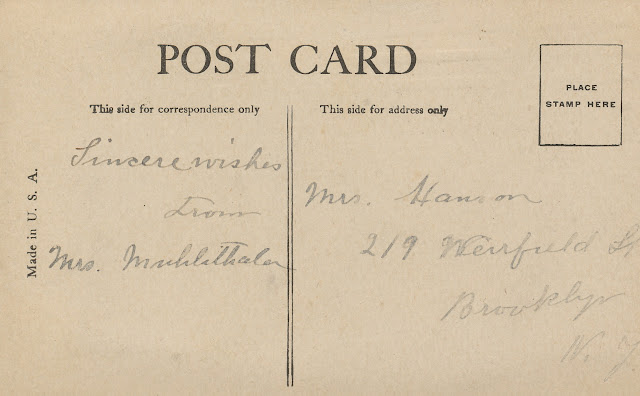Tuesday, December 8, 2009
Birthday Greetings - Silk Embroidered Card
I'm only familiar with the French silk embroidered cards, but this one was made in the United States, presumably right around 1920. If you're interested in silk postcards, Bill from the U.K. has a great website.
Monday, December 7, 2009
Guess Who Sent You This Fish Airplane

Back in the old days in France (up until 1564), the new year was celebrated on April first, based on the Julian calendar. That was before King Charles IX came along and decided that everybody should be following the Gregorian calendar, which starts the new year on the first day of January. Not everyone welcomed this change, or so the story goes, and some people continued to celebrate April 1 as the first day of the year. Allegedly, those people were mocked and referred to as April fools. Whatever the case, it became a tradition to do things such as pasting a fish on unsuspecting people's backs on April 1, and calling them a Poisson d'Avril or an April Fish. The symbol of the fish may also have been connected with Jesus Christ.
There is another theory that the traditions were inspired by the abundance of newly-hatched fish in French rivers in the Spring. These fish, who had not yet acquired their stream smarts, were easy to catch, and referred to as Poisson d'Avril. Because of the fish, it became customary to fool people on April first. It's still a tradition to give chocolate fish as a present and at one time it was also very popular to send, often anonymously, postcards featuring fish. Somewhere along the line, these cards also became romantic, with the fish symbolizing remembrance and secret feelings.
Sunday, December 6, 2009
Streetcar Sundays - Portstewart, Ireland

Once again, it's streetcar Sunday, and I'm excited about today's picture of this tram in Portstewart, on the northern coast of Ireland. You may be asking, what's the difference between a streetcar and a tram? People in the United States call it a streetcar and people in the U.K. call it a tram. That's pretty simple. They are the same, but then again not all streetcars are alike. Take this one for example, no wires are visible because it was steam powered. In fact, the Portstewart tram was the first steam tramway in Ireland. The fact that it's steam powered is one of the things I love about this particular picture, and the fact that each car is different. I'm not sure why all those people are crowded on top of the third car and the second car is entirely empty. The last car looks as if it is used for luggage.
The Portstewart tram was a 3-foot guage tramway that connected the seaside town of Portstewart with the mainline railway, which ran from Belfast to the neighboring town of Portrush, but which by-passed Portstewart by a couple of miles. The tramway started service in 1882. The Portstewart tram closed down in 1926, unable to compete with bus service.
Here's a close-up:

During the era of steam trains, steam tram engines were governed by specific rules. For one thing, the steam could not be visible, so they had to use coke rather than coal as a fuel. They were also required to conceal all machinery from view at all points above 4 inches from the rails, which is why this engine has such an odd profile. Finally, they also had to be quiet, and they couldn't exceed 8 miles per hour. Most steam-powered trams were phased out in favor of electric trams in about 1900.
The picture above is not actually a postcard; it's from a little folder of real photo snapshots. You would write the address on the outside of the packet and send the whole thing.
If you're interested in Irish steam trains, check out the website for the Railway Preservation Society of Ireland. There are also two restored cars from the Portstewart tramway available to view in two separate museums, the Streetlife Museum of Transport in Kingston upon Hull, England (admission is free!) and the Ulster Folk and Transport Museum in Cultra, Northern Ireland.
Come back next week for another Streetcar Sunday!
Subscribe to:
Comments (Atom)


















